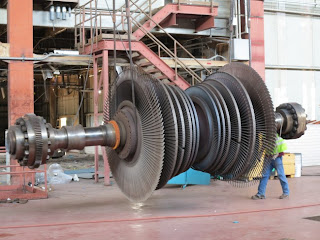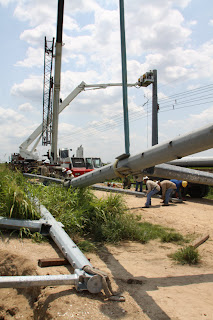Holly Power Plant Decommissioning Update: Removal of the turbines from Holly Generating Units 1 and 2 continues. This includes removing the principal pieces that compose the electrical generating system for the plant.
The images below show Holly 2’s generator rotor being shipped off the site and the turbine crew removing the low pressure turbine rotor. The full removal of the plant will be completed by spring 2013. Website: http://www.holly.austinenergy.com.
The Holly 2 generator rotor is loaded onto a trailer for shipment off site.
The generator rotor is tightly braced onto the trailer.
The truck trailer rig moves onto the weight scale to take note of the rotor weight leaving the plant.
The Holly 2 generator rotor leaves the plant and the steel will be recycled.
The Holly 2 low pressure turbine sits between the generator on the right and the high pressure turbine on the left. The white color seen on the turbine is a coating used to bond any loose particulates to the turbine casing.
The low pressure turbine casing sits ready to be lifted and removed.
The low pressure turbine casing is placed on the turbine floor.
The low pressure turbine rotor sits exposed and ready for lift off.
A worker is directing the low pressure turbine to the truck bay.
The low pressure turbine bottom casing with its stationary blades sits empty and rotorless.
The low pressure turbine rotor is maneuvered into the truck bay.
The workers direct the low pressure turbine rotor in the truck bay so that it can be removed into the chopping and loading area.

































.JPG)
.JPG)
.JPG)




